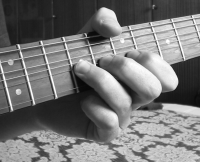Guitar/Bending and Vibrato
Bending and vibrato are two related effects which help give extra "life" to notes, especially sustained notes, by changing their pitch. The techniques are not commonly used on the acoustic guitar or general rhythm playing. However, they are extremely important to many styles involving distorted guitar, e.g., rock or metal, even when playing rhythm (though, in that case, bends and vibratos are usually embellishments). Bending or an equivalent effect is not possible on all instruments; the piano, for example, cannot have notes that change in pitch. This is one reason why it is important to know how to bend: because you can!
This section deals with bending and vibrato using your fingers, not the different technique of using the vibrato bar. The two techniques do the same basic thing, but using the vibrato bar as a substitute for fretting-hand bending is not good practice; it is best used for very heavy bends or heavy vibratos, not slight embellishments like finger bending. It is more difficult to be subtle with a vibrato bar, and it is usually a bit out of the way for the picking hand to reach, making it harder to use. In short, while in some cases which style of bending or vibrato is used is a matter of taste, the two techniques are not interchangeable and are used for different effects.
Bending
[edit | edit source]
Bending is exactly as it sounds: bending the string to the side by pushing it (towards the sixth string) or pulling it (towards the first string), often while a fretted note is ringing. The first three strings are normally pushed, and the others are normally pulled. This is particularly important on the first and sixth strings, as you do not want the string to fall off the fretboard. Whether the string is pushed or pulled, the note will be raised in pitch.
Many aspiring guitarists cannot bend properly. The sound of a bend is more important than how it is actually executed or how it looks, but a bad bending technique usually leads to a bad sound. Your favorite guitarist might bend using just his or her fingertips and you might be inclined to copy this — don't! Your hands can sound every bit as good as your hero's without copying his or her technique. There are two keys to bending properly: proper thumb positioning, and bending with the proper muscles. Do not keep your thumb behind the neck, where it usually is, but bring it up perpendicular to the neck (a position that is normally incorrect, but not in the case of bending). Keep the fingers firm. Do not bend your fingers, but push or pull with your forearm. You will hardly see your forearm move, possibly just see a couple of muscles flex. It will feel awkward at first, but if you can bend with the thumb in the proper position and without bending the fingers, you are probably doing it correctly.
Many guitarists will have trouble bending more than 1/4 step (half a semitone) or perhaps 1/2 step (one semitone) with only one finger, especially on frets close to the nut and on the thinner strings. It is much easier to bend with more than one finger, for instance, with the index finger on the first or second fret and the ring finger on the third, and pushing or pulling with both fingers in order to bend at the third fret. More fingers may be used if this is not enough. It should be possible to bend at least a full step (the pitch difference of two frets) this way.
Pre-bending
[edit | edit source]Bending, whether by pushing or pulling the string, raises the tension in the vibrating portion of the string, and thus always raises the pitch of the note. This means it is easier to slide up rather than down in pitch. To create the impression of bending down, the guitarist uses a technique called pre-bending, that is, bending before the string is struck, then strike and release the bend (either gradually or quickly, depending on the intended effect).
Bend and Release
[edit | edit source]The ideas of bending and pre-bending can be combined for a "bend and release", that is, striking a note, bending it up, then releasing it as you would with a pre-bend. This will often be perceived as a "bounce" in pitch, especially if played quickly. The reverse is also possible: pre-bend, release, and bend. Repeatedly and steadily bending and releasing is called vibrato.
Vibrato
[edit | edit source]Players of many instruments, including the human voice, use vibrato to help add expression to sustained notes. Vibrato is performed in two major ways, the first by rapidly bending the string back and forth, causing a modulation in pitch; therefore, all of the information above about bending applies here, except it is performed faster or more prolonged. Or it can be performed in a 'classical' style where one applies pressure parallel to the string towards the neck then towards the bridge repeatedly, which allows one to achieve vibrato upward and downward in pitch, albeit with a smaller change. A small, subtle vibrato might not require the assistance of other fingers; the fretting finger should be sufficient. However, for sustained vibrato or vibrato on the first or second frets, using multiple fingers for bending is a good idea.
